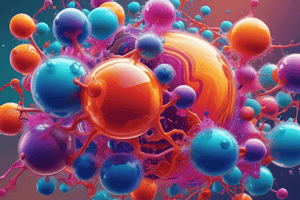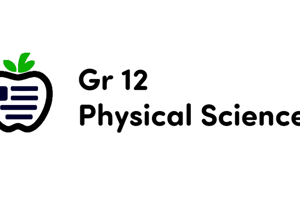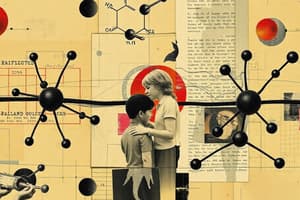Podcast
Questions and Answers
Which observable sign is typically associated with chemical changes?
Which observable sign is typically associated with chemical changes?
- Change in state of matter
- Color change (correct)
- Change in shape
- Volume change
What type of bond is formed when one atom loses electrons and another gains electrons?
What type of bond is formed when one atom loses electrons and another gains electrons?
- Hydrogen bond
- Metallic bond
- Covalent bond
- Ionic bond (correct)
Which of the following reactions is an example of a chemical change?
Which of the following reactions is an example of a chemical change?
- Rusting of iron (correct)
- Dissolving sugar in water
- Boiling water
- Melting of ice
In a chemical reaction, what is required to break existing chemical bonds?
In a chemical reaction, what is required to break existing chemical bonds?
What distinguishes covalent bonds from ionic bonds?
What distinguishes covalent bonds from ionic bonds?
What determines whether a reaction is exothermic or endothermic?
What determines whether a reaction is exothermic or endothermic?
How do stronger chemical bonds affect a compound's properties?
How do stronger chemical bonds affect a compound's properties?
Which process directly involves the rearrangement of atoms in a chemical change?
Which process directly involves the rearrangement of atoms in a chemical change?
Flashcards
Chemical Change
Chemical Change
A process that involves the rearrangement of atoms, resulting in the formation of new substances with different properties.
Bond Breaking and Formation
Bond Breaking and Formation
The breaking and forming of chemical bonds that occur during a chemical change.
Chemical Bond
Chemical Bond
A force that holds atoms together in compounds, arising from the electrostatic attraction between oppositely charged particles.
Ionic Bond
Ionic Bond
Signup and view all the flashcards
Covalent Bond
Covalent Bond
Signup and view all the flashcards
Metallic Bond
Metallic Bond
Signup and view all the flashcards
Bond Breaking Energy
Bond Breaking Energy
Signup and view all the flashcards
Bond Forming Energy
Bond Forming Energy
Signup and view all the flashcards
Study Notes
-
Chemical Changes
- Chemical changes involve the rearrangement of atoms to form new substances with different properties.
- These changes are often accompanied by observable signs such as color changes, heat release or absorption, gas evolution, or precipitate formation.
- Chemical changes result in the breaking and forming of chemical bonds.
- Examples include combustion, rusting, and the digestion of food.
- Unlike physical changes, chemical changes result in a transformation into a new substance.
- The original substance is altered at a molecular level.
Chemical Bonds
- Chemical bonds are forces that hold atoms together in compounds.
- These bonds are the result of electrostatic attraction between oppositely charged particles.
- Key types of chemical bonds include:
- Ionic bonds: Form between a metal and a nonmetal, where one atom loses electrons (becoming a positive ion) and the other gains electrons (becoming a negative ion). The electrostatic attraction between these oppositely charged ions forms the bond.
- Covalent bonds: Form between two nonmetals, where atoms share one or more pairs of valence electrons to achieve a more stable electron configuration. The shared electrons are attracted to the nuclei of both atoms.
- Metallic bonds: Occur in metals, where valence electrons are delocalized and shared among a lattice of metal ions. This creates a "sea of electrons" holding the metal ions together.
- Bond strength varies considerably, affecting the properties of the resulting compound. Stronger bonds are associated with more stable compounds.
- The properties of a substance are often determined by the type and strength of the bonds present in it.
Relationship Between Chemical Changes and Chemical Bonds
- Chemical changes inevitably involve the breaking and reforming of chemical bonds.
- Existing bonds in the reactants are broken, requiring energy input.
- New bonds are formed in the products, releasing energy.
- The difference between the energy required to break the bonds and the energy released in forming new bonds determines whether the reaction is exothermic (releases heat) or endothermic (absorbs heat).
- The rearrangement of atoms and breaking and forming of chemical bonds are fundamental for the occurrence of all chemical reactions and hence chemical changes.
- Different types of chemical bonds have different strengths, thus influencing the nature of the chemical change.
Studying That Suits You
Use AI to generate personalized quizzes and flashcards to suit your learning preferences.




